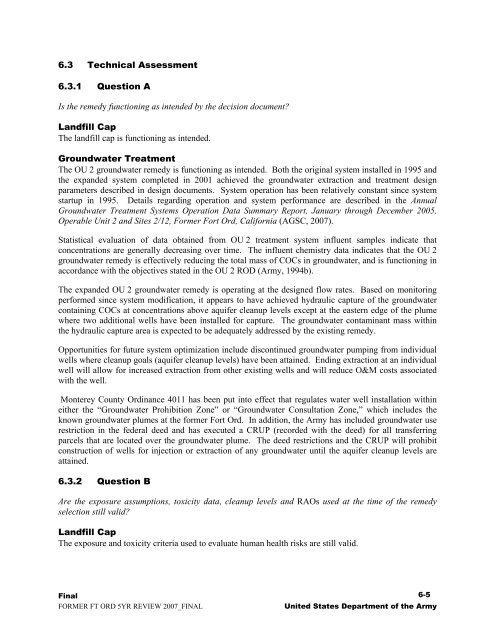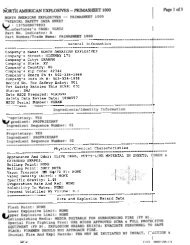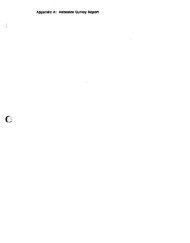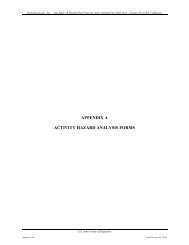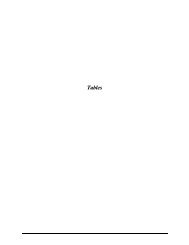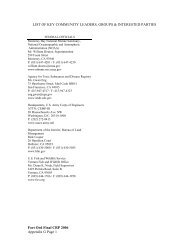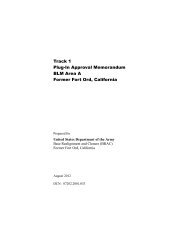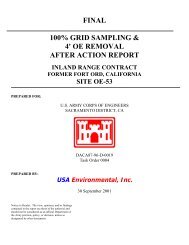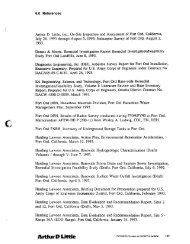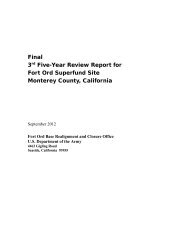Final Second Five-Year Review Report Fort Ord Superfund Site ...
Final Second Five-Year Review Report Fort Ord Superfund Site ...
Final Second Five-Year Review Report Fort Ord Superfund Site ...
You also want an ePaper? Increase the reach of your titles
YUMPU automatically turns print PDFs into web optimized ePapers that Google loves.
6.3 Technical Assessment<br />
6.3.1 Question A<br />
Is the remedy functioning as intended by the decision document?<br />
Landfill Cap<br />
The landfill cap is functioning as intended.<br />
Groundwater Treatment<br />
The OU 2 groundwater remedy is functioning as intended. Both the original system installed in 1995 and<br />
the expanded system completed in 2001 achieved the groundwater extraction and treatment design<br />
parameters described in design documents. System operation has been relatively constant since system<br />
startup in 1995. Details regarding operation and system performance are described in the Annual<br />
Groundwater Treatment Systems Operation Data Summary <strong>Report</strong>, January through December 2005,<br />
Operable Unit 2 and <strong>Site</strong>s 2/12, Former <strong>Fort</strong> <strong>Ord</strong>, California (AGSC, 2007).<br />
Statistical evaluation of data obtained from OU 2 treatment system influent samples indicate that<br />
concentrations are generally decreasing over time. The influent chemistry data indicates that the OU 2<br />
groundwater remedy is effectively reducing the total mass of COCs in groundwater, and is functioning in<br />
accordance with the objectives stated in the OU 2 ROD (Army, 1994b).<br />
The expanded OU 2 groundwater remedy is operating at the designed flow rates. Based on monitoring<br />
performed since system modification, it appears to have achieved hydraulic capture of the groundwater<br />
containing COCs at concentrations above aquifer cleanup levels except at the eastern edge of the plume<br />
where two additional wells have been installed for capture. The groundwater contaminant mass within<br />
the hydraulic capture area is expected to be adequately addressed by the existing remedy.<br />
Opportunities for future system optimization include discontinued groundwater pumping from individual<br />
wells where cleanup goals (aquifer cleanup levels) have been attained. Ending extraction at an individual<br />
well will allow for increased extraction from other existing wells and will reduce O&M costs associated<br />
with the well.<br />
Monterey County <strong>Ord</strong>inance 4011 has been put into effect that regulates water well installation within<br />
either the “Groundwater Prohibition Zone” or “Groundwater Consultation Zone,” which includes the<br />
known groundwater plumes at the former <strong>Fort</strong> <strong>Ord</strong>. In addition, the Army has included groundwater use<br />
restriction in the federal deed and has executed a CRUP (recorded with the deed) for all transferring<br />
parcels that are located over the groundwater plume. The deed restrictions and the CRUP will prohibit<br />
construction of wells for injection or extraction of any groundwater until the aquifer cleanup levels are<br />
attained.<br />
6.3.2 Question B<br />
Are the exposure assumptions, toxicity data, cleanup levels and RAOs used at the time of the remedy<br />
selection still valid?<br />
Landfill Cap<br />
The exposure and toxicity criteria used to evaluate human health risks are still valid.<br />
<strong>Final</strong><br />
6-5<br />
FORMER FT ORD 5YR REVIEW 2007_FINAL United States Department of the Army


